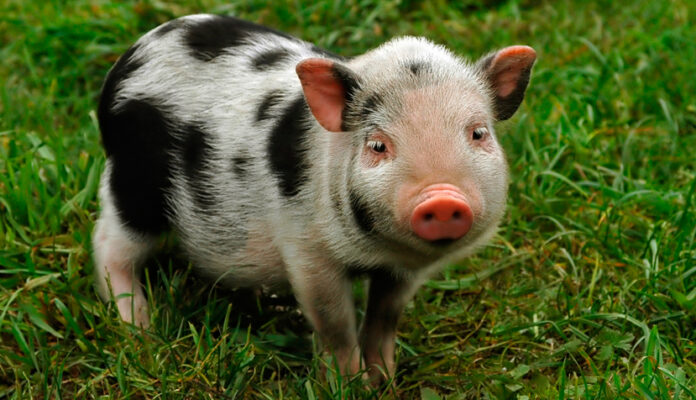Last Updated on July 2, 2021 by Fumipets
Micro-pigs have seen a surge in popularity in recent years, thanks to social media platforms, celebrity pet pig owners, and a number of television programmes and movies highlighting the animals. Teacup pigs, also known as Juliana pigs, are little four-legged pets that are not only common on farms but are now becoming more popular in households.
The adorable footage of tiny piglets snuggling with puppies or sipping from similarly small bottles has most likely caught your eye on the internet. Do teacup pigs, on the other hand, remain that tiny forever? Do they make excellent pets as well?
No one can dispute the adorableness of “teacup” pigs, but sadly, there are a lot of myths and misunderstandings about them that may be detrimental to their health and well-being in the long run.
Incorporating a “teacup” pig into your household may have significant consequences—both for the pig and for the rest of your family—so it’s critical to do thorough research before contacting a breeder. Read on to find out more about “teacup” pigs and why they may not be the best choice for you as a pet.

1. “Teacup” Pigs Don’t Really Exist
Nope, “teacup” is not a breed of pig, and it’s not quite a nickname for a new breed either. Instead, “teacup” is a term that breeders use to refer to normal potbellied pigs who have been starved in order to impede their development or that have been fraudulently marketed as miniatures by their marketing departments.
It is true that domesticated potbellied pigs are typically smaller than the ordinary farm pig. They may weigh between 100 and 200 pounds, while farm pigs can reach up to 1,000 pounds on average. However, this is a long cry from the 10 to 12-pound “teacup” promise made by many breeders. Even the tiniest potbellied pig will weigh between 60 and 80 pounds, depending on its size. Depending on the pig’s size, activity level, and surroundings, they may be regarded to be underweight or overweight.
2. Maintaining a “Teacup” Pig’s Small Size Seriously Hurts Their Health
Many “teacup” breeders employ harsh techniques to keep their pigs tiny or restrict their development, and it’s difficult to hear them say this. The following are two of the most often used techniques:
Inbreeding: Potbellied pigs are inbred to ensure that their lower height is passed down through generations. This lack of genetic variation in their offspring may result in a wide range of health problems in their offspring.
Starvation: Another method used by many “teacup” breeders to guarantee that their pigs are of smaller height is to underfeed them in order to impede their development. They often urge their owners to severely limit their own diets as well. In essence, these pigs are starving to death, and as a result, they will not flourish. As a consequence, what happened? In addition to bone abnormalities and bone fragility, among other severe health problems, the pigs’ internal organs continue to develop to their full size despite the fact that their skeletal systems have remained tiny.
/cdn.vox-cdn.com/uploads/chorus_asset/file/13281667/Screen_Shot_2018_10_16_at_3.57.48_PM.png)
3. With “Teacup” Pigs, what you see is not always what you get.
If a “teacup” breeder shows you the parents of your prospective piggy, it is likely that he or she is just showing you potbellied piglets. Pigs may begin reproducing as early as three months of age. As a result, parents of piglets are frequently piglets themselves, which means that you cannot predict the size of your “teacup” pig solely on the size and look of his or her parents.
Furthermore, some unscrupulous “teacup” pig breeders would merely display prospective customers baby potbellied pigs, who will ultimately grow into full-sized teenagers and adults rather than breeding them.
4. “Teacup” pigs are very expensive to purchase.
For those considering purchasing a “teacup pig,” be prepared to spend anything between $750 to $3,500 on your new pet. After purchasing a pig as a pet, the expense of maintenance continues to rise.
Because many “teacup” owners assume their pigs will stay tiny, they don’t even think about the costs of keeping a 100-pound (or more) pig in their own house, which may add up quickly. It may cost thousands of dollars each year to keep a pig due to the cost of providing a sufficient food supply (potbellied pigs eat a lot), veterinary visits and vaccines, and other pig-related expenses. Additionally, spaying or neutering pet pigs are advised to decrease the likelihood of undesirable habits and the danger of some malignancies.
However, this may be problematic due to the difficulty in locating a specialist veterinarian who is qualified to conduct the operation.
5. The life expectancy of “teacup” pigs is very short.
Because of problems with their skeletal and immunological systems, a “teacup” pig’s lifetime is usually limited to five years, while the average potbellied pig’s lifespan is anticipated to range between 12 and 18 years. Genetic diseases induced by inbreeding may also result in a reduced life span in certain individuals.

6. Pigs need a large amount of space.
Overall, pigs take up an enormous amount of room, and not only because they are big. Pigs need regular activity in order to avoid becoming bored, which may result in destructive or violent behaviour on the part of the animal. It is possible for them to grow hostile towards people, biting or charging. Many pigs are abandoned or surrendered to animal shelters simply because their owners do not have the room to provide them with a happy, healthy, and engaging environment.
7. Owning Any Kind of Pig May Be Illegal Where You Live
Keep in mind that owning a pig as a pet may be against the law in your area. Pigs are considered exclusively to be farm animals under zoning regulations in many states, and they are not permitted to be kept in non-farming or non-agricultural environments.
In order to determine whether or not you are allowed to keep animals in your region, consult the zoning regulations in your area. Every year, thousands of farmed pigs are abandoned or surrendered due to lack of care. A small amount of research may help avoid this.
8. Pigs Are Herd Animals
Did you know that pigs are very social creatures? Pigs form “packs,” much like dogs, and they spend a lot of time together, playing, resting, and sleeping. When a pig is deprived of social contact, he or she may grow bored, restless, or sad, and he or she may behave violently as a result of this.
While it is recommended to maintain at least two pigs at the same time, many “teacup” owners who find themselves suffering with a pig weighing more than 100 pounds will find themselves struggling even more with two or more pigs. Not to mention that doubling the number of pigs means doubling the amount of money spent on food, supplies, and veterinarian appointments.

9. Having a pig is not the same as having a cat or a dog.
It is true that pigs are highly clever and playful creatures who are capable of establishing strong and loving relationships with their human companions. They’re the ideal pet for certain households, after all! Having a pig, on the other hand, is a completely different experience than having a cat or a dog. New pig owners are often taken aback by the amount of time and money it takes to run a successful pig operation.
Unfortunately, many people who buy “teacup” pigs are not prepared for them to develop into full-sized teenagers and adults. This is especially true for individuals who live in apartments. They are often given to animal shelters or just abandoned if they get too big, suffer from health issues, or exhibit destructive behaviour, among other reasons.
What’s the bottom line? Consider if you have the room, enough patience, and the financial resources to maintain a pig happy and healthy before making a decision on whether to get one.


















